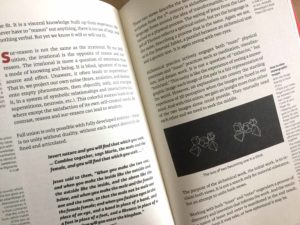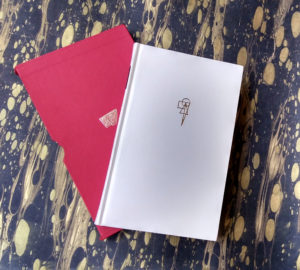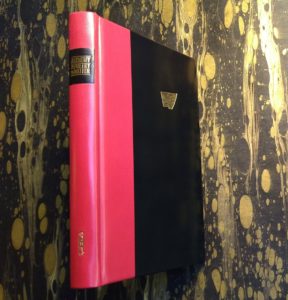Alchemy: The Poetry of Matter
Alchemy: The Poetry of Matter
Brian Cotnoir
Khepri Press 2017
Hardcover. 172 pages. Illustrated. Numbered Limited Edition of 800.
ABOUT THE PROJECT AND THE BOOK
Alchemy: The Poetry of Matteris the result of a 45-year study and practice of alchemy. I began the project in 1973. In 1986, as my worked gained focus, and inspired by Diotima’s statement to Socrates in Plato’s Symposiumto the effect that anyone who creates something out of nothing is a poet, I called the project “The Poetry of Matter” – a series of studies and experiments towards a poetry of matter. The phrase evokes the idea of deep structures and compositions comprised of elements – the world as material energetic poetry and alchemy – the composition.
In fact, the result of this project “The Poetry of Matter” is a three-volume work. Volume I, published in 2006, is the Weiser Concise Guide to Alchemy. It is a concrete, practical approach to alchemy and provides the basics of its theory and practice. Volume II, the book presented here, is a more complete and perhaps a more abstract approach and manner of working. It is a deepening of practice and a more personal work. Volume III, Alchemy: The Poetry of Matter – Opus Magnum, is a four-part book-object that is a culmination of the previous two volumes. Working with alchemical processes and materials composing words, phrases, and pages, it is a nearly wordless attempt to approach an authentic expression of alchemy.
The present book, Alchemy: The Poetry of Matter,isthe result of a personal exploration of the union of material and non-material alchemical practices, that is, of physical alchemy and inner alchemy.Through this practical work I have come to define alchemy as the art and science of bringing something to its final perfection, or its completion, as much as a work of art is completed or perfected.
Early alchemical texts can be read as both laboratory protocols and spiritual inner practices. It is the art of seeing with both eyes.
“Alchemical practice actively engages both “outer” physical processes and “inner” practices such as meditation, visualization, and dream work. It is not a question of “either/or,” but “both/and.” This unity is like the experience of seeing a stereographic image: each image of the pair is a fair representation of the world. However, no explanation can convey the startling experience of 3D perception when the images are fused in our mind. And with this union, we gain an insight more than either of the two images alone could provide. They mutually need each other and we need to seek the middle.“ Alchemy: The Poetry of Matter, p73.
Rooted in the Alexandrian alchemical tradition and working from my new translation of the Emerald Tablet, and through direct experimentation, I investigate several areas in light of the Emerald Tablet– Chrysopoiea (gold composition); the Green Lion (a key compound in the work); the Quintessence; and Aurum potabile (a drinkable gold). Unique to the book are five new translations of the earliest extant manuscripts of the Emerald Tablet, as well as translations of John of Rupescissa’s and Arnald of Villanova’s writings on the quintessence of wine and gold.
While the material work described in the book is explicitly alchemical, the same relationship of creator/created holds for all creative practices of art regardless of the medium. This is one of the statements and conclusions of the Emerald Tablet; that the inner alchemical practices of visualization, dream work, and the dialogue with matter translate directly to any creative process or medium. It is about creating in any medium, and so at heart, it is about creation, creator, and creativity.
From the beginning, the design of the book, working with alchemical principles, evolved along with the writing and experimentation.
Alchemy, like all art, works with elements, their compositions, and, surprisingly, perhaps geometry. Geometry, in its original intent and deeper practice, is similar to alchemy in that both are concerned with the ascent of the soul by working with elements in seeking the sources of creation. The DNA of the book and cover design draws from both geometry and alchemy. All elements (text, graphic, image, word, intent, etc.) were involved in the making of the book from the beginning. The structure of the book, its images, text, and concrete poems, all play with alchemical concepts such as circulation, the interplay between fixed and volatile, and contraction/expansion. The side notes, references, and images are islands through which the main ideas of the text flow. They sometimes directly refer to the text, sometimes resonate with it, they sometimes act as a link between two distant passages. Once I had worked out the initial placement of the elements in their proper relationship to the meaning of the text, I made a mock-up of the book and cover. Lara Captan started working with me, harmonizing the various elements and bringing many ideas to the design.
One major area of her expertise is in Arabic typesetting using the A.C.E. (Arabic Calligraphy Engine developed by DecoType Amsterdam) and typeface design. In fact, she designed the two Arabic typefaces Kanat and Falak used in the book. As the book started taking a cleaner, more finished form, some of the alignments amongst the elements would shift, yielding unexpected connections, so we would make adjustments either to correct or to incorporate the new connections. This for me was one of the great joys in making this book – the design process with Lara – a playful creative back and forth where we found the best ideas and forms, and in this way, the book’s evolution continued and accelerated to its completion.
And so, in its content, form and making, it is an alchemical bookrather than a book about alchemy. Full of practice and experiment and perhaps a puzzle or an enigma, its intent is to inspire curiosity about another way of knowing through our creative work.
To order go to Khepri Press
Hardcover Numbered Limited Edition of 800. $75.00
Special Edition: Full Imperial Vellum with goldstamped device and black leather title label also in gilt. Housed in a red slipcase with labyrinth device stamped in gold. SOLD OUT
Deluxe Edition: Red and Black two-tone full leather binding with gilt title and devices. SOLD OUT
For more information or to buy go to Khepri Press
Bio
Brian Cotnoiris an alchemist, artist, and filmmaker. A contributor to Frater Albertus’ Parachemy, he is also theauthor of a series of Alchemy Zines. His books include The Weiser Concise Guide to Alchemy, Alchemical Meditations, On the Quintessence of Wine, and the recently published Emerald Tablet, his translations of and commentary on, the earliest Arabic and Latin versions of this seminal text. His Emerald Tabletwas part of the Language of the Birds: Occult and Artshow in 2016 in New York City. An alchemical composition of his “Egonomen nekros,” is part of the 2018 exhibition at Green-Wood Cemetery,The Power of Image: Life, Death, and Rebirth.
He occasionally gives talks and has presented workshops and seminars around the world on various aspects of alchemical theory and practicebased on his research.
His film work has been screened at Museum of Modern Art, Sundance Film Festival, HBO, PBS and other international venues.
Khepri Press, launched in 2014 with the publication of the Emerald Tablet, is the vehicle and portal for his alchemical work.














